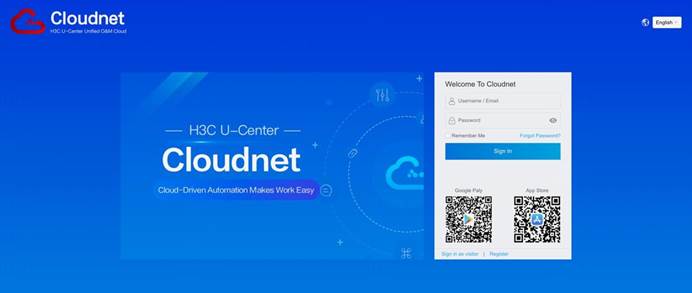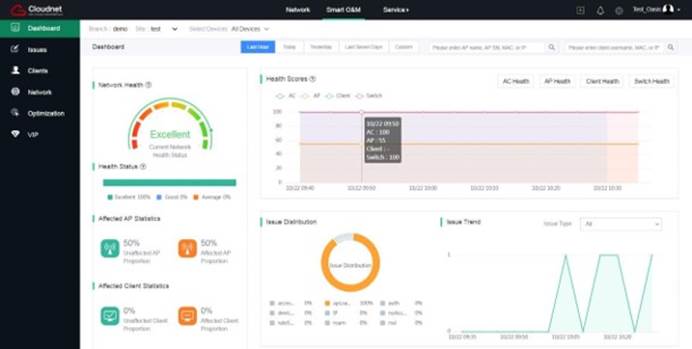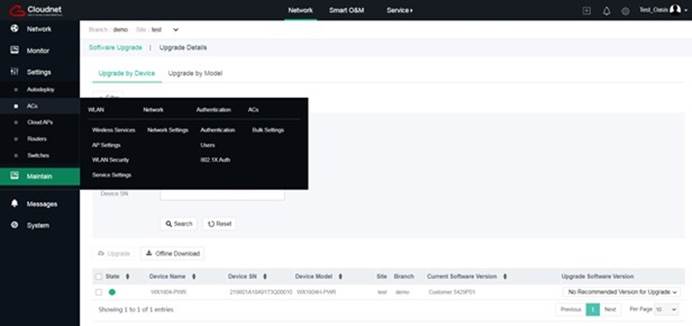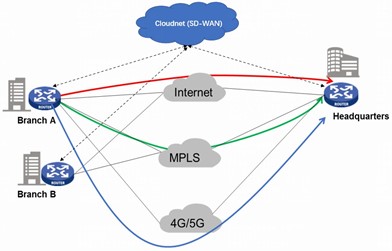- Products and Solutions
- Industry Solutions
- Services
- Support
- Training & Certification
- Partners
- About Us
- Contact Sales
- Become a Partner
-
 Login
Login
Country / Region
Cloudnet
H3C Cloudnet is a H3C-proprietary comprehensive operation management and maintenance platform. Based on H3C unified O&M cloud platform, It provides a light-weight and multi-service platform to manage network and a powerful O&M service for small business. It uses Kubernetes for containerized applications and a fully distributed architecture to provide management of networks, terminals, users, and service enabling features. With management and monitoring of multiple network services, the platform breaks the data barriers between services caused by isolated and vertical service deployment.
H3C Cloudnet supports the delivery model of public clouds and provides customers with comprehensive network solutions to meet the needs of customers from different industries and operators.

H3C Cloudnet
The following contents are complex, and it is recommended to browse on PC.

Enter c.h3c.com.cn on the PC browser and operate according to the page to synchronize to the PC and continue browsing.
Continue by mobile
Cloud authentication
Support Facebook authentication, one-click authentication, fixed account authentication, Portal authentication, WeChat authentication, visitor QR code authentication, dumb terminal authentication, etc. Support the ability to customize the authentication page, full graphical configuration, what you see is what you get; support drag and drop to adjust the layout, support text, pictures, carousel diagrams, videos, authentication boxes, buttons, and other parts of the customization. Support developer mode, support users to develop authentication pages by themselves; support separate allocation of permissions, and authorize operators. Customization and pages bring the ultimate experience to user operations.

Various authentication methods for users to choose
Network O&M
Support one-key inspection, one-key network optimization and other functions, enabling users to complete network detection and optimization with simple click operations. The intelligent operation and maintenance of Cloudnet makes the network resource information visible, automatically senses the hidden dangers of the entire network, and automatically eliminates the entire network failure. Tracking and automatically always optimizing the network, so that the network is always in the best state, providing users with an excellent online experience.

Smart O&M escorts networks
Role-based access control
With role-based access control (RBAC), you can perform fine-grained access management of the Cloudnet platform. A user can create subaccounts with different user roles and authorize them with different sites or branches to separate rights and achieve hierarchical management.

Subaccount authority
Terminal management
The platform provides unified management of various terminals to reduce management costs.
Full network management
The Cloudnet platform supports full-standard network connection and management, wired and wireless integration, supports unified monitoring, configuration, maintenance, and operation of switches, routers, wireless ACs, APs, and security devices, and provides unified cloud management.

Device management

Device monitoring

Device configuration

Device maintenance
Automated WAN service deployment
The SD-WAN solution supports automated deployment of VPN services, LAN services, and QoS services across the whole network. You can define applications based on the IP 5-tuple, DSCP, VPN information, and application-layer packet signatures. You can define policies based on route selection, bandwidth, and service quality requirements and the time range.
![]() VPN service deployment—After a device comes online, the SD-WAN automatically deploys IPsec tunnel settings if the WAN interface of the device connects to the Internet. Meanwhile, the SD-WAN creates a SD-WAN tunnel for each WAN link to provide consistent traffic engineering, irrespective of their link types.
VPN service deployment—After a device comes online, the SD-WAN automatically deploys IPsec tunnel settings if the WAN interface of the device connects to the Internet. Meanwhile, the SD-WAN creates a SD-WAN tunnel for each WAN link to provide consistent traffic engineering, irrespective of their link types.
![]() LAN service deployment—The SD-WAN automatically deploys LAN service settings to devices at the branch sites, eliminating the need to configure the devices one by one manually. The CPE device can be deployed as a Layer 3 gateway at the branch site, or it can connect to the Layer 3 network in the branch through a routing protocol.
LAN service deployment—The SD-WAN automatically deploys LAN service settings to devices at the branch sites, eliminating the need to configure the devices one by one manually. The CPE device can be deployed as a Layer 3 gateway at the branch site, or it can connect to the Layer 3 network in the branch through a routing protocol.
![]() Agile QoS service deployment—From the application group configuration page, you can configure the maximum bandwidth to implement application group-based rate limiting on LAN interfaces of devices. If the bandwidth rented from a service provider is smaller than that of the interface, you can configure a rate limit for the WAN interface to prevent excess traffic from being dropped by the service provider. If traffic flows with multiple priorities exist in the network and congestions occur, you can configure an assurance profile to ensure low latency for high priority traffic by assigning a high priority queue and more bandwidth to it. You can make dynamic bandwidth and rate limit adjustments based on real-time network conditions to protect core network applications. For example, in special or critical periods, you can block or rate-limit illegitimate traffic or low-priority traffic to ensure the bandwidth requirements of high-priority services.
Agile QoS service deployment—From the application group configuration page, you can configure the maximum bandwidth to implement application group-based rate limiting on LAN interfaces of devices. If the bandwidth rented from a service provider is smaller than that of the interface, you can configure a rate limit for the WAN interface to prevent excess traffic from being dropped by the service provider. If traffic flows with multiple priorities exist in the network and congestions occur, you can configure an assurance profile to ensure low latency for high priority traffic by assigning a high priority queue and more bandwidth to it. You can make dynamic bandwidth and rate limit adjustments based on real-time network conditions to protect core network applications. For example, in special or critical periods, you can block or rate-limit illegitimate traffic or low-priority traffic to ensure the bandwidth requirements of high-priority services.
Intelligent and flexible traffic engineering policies
The SD-WAN solution supports various types of traffic engineering policies.

![]() Traffic engineering based on bandwidth usage, link coloring, and other factors—Assume that two services run on the same link under normal circumstances. When the bandwidth usage of the link reaches the threshold, the device automatically steers service traffic to the other link according to the traffic engineering settings deployed by SD-WAN to ensure user experience.
Traffic engineering based on bandwidth usage, link coloring, and other factors—Assume that two services run on the same link under normal circumstances. When the bandwidth usage of the link reaches the threshold, the device automatically steers service traffic to the other link according to the traffic engineering settings deployed by SD-WAN to ensure user experience.
![]() Traffic engineering based on latency, jitter, packet loss rate, and other factors—Assume that two services run on the same link under normal circumstances. When the latency on the link reaches the threshold, the device automatically steers service traffic to the other link according to the traffic engineering settings deployed by SD-WAN to ensure user experience.
Traffic engineering based on latency, jitter, packet loss rate, and other factors—Assume that two services run on the same link under normal circumstances. When the latency on the link reaches the threshold, the device automatically steers service traffic to the other link according to the traffic engineering settings deployed by SD-WAN to ensure user experience.
![]() Time range-based traffic engineering—You can configure SD-WAN to enforce different traffic engineering policies during different time ranges to ensure guaranteed delivery of high-priority services in the desired time ranges.
Time range-based traffic engineering—You can configure SD-WAN to enforce different traffic engineering policies during different time ranges to ensure guaranteed delivery of high-priority services in the desired time ranges.
WAN acceleration
The SD-WAN solution supports Web caching and Forward Error Correction (FEC) for acceleration and optimization of applications on the WAN.
![]() Web caching: When a user first accesses a Web page through HTTP or HTTPS, the device caches the Web page content locally. The next time the same content is requested (within the aging time), the device directly serves the content from the cache. This helps speed up the application load time by at least 400% and improve Webpage access efficiency by 100%.
Web caching: When a user first accesses a Web page through HTTP or HTTPS, the device caches the Web page content locally. The next time the same content is requested (within the aging time), the device directly serves the content from the cache. This helps speed up the application load time by at least 400% and improve Webpage access efficiency by 100%.
![]() FEC: FEC is a technique used for controlling errors in data transmission over unreliable or noisy communication channels. The sender automatically calculates and adjusts the ratio of redundant packets according to the real-time packet loss rate obtained through end-to-end link quality detection to ensure low packet loss rate at the expense of little link bandwidth. This helps improve data transmission for real-time services such as voice and video services over low-SLA links such as Internet links.
FEC: FEC is a technique used for controlling errors in data transmission over unreliable or noisy communication channels. The sender automatically calculates and adjusts the ratio of redundant packets according to the real-time packet loss rate obtained through end-to-end link quality detection to ensure low packet loss rate at the expense of little link bandwidth. This helps improve data transmission for real-time services such as voice and video services over low-SLA links such as Internet links.
Multi-service
The Cloudnet provides various business functions including cloud engineering survey, large-screen monitoring, PPSK, cloud authentication, hotel management, etc., which comprehensively shows the business capacity of Cloudnet in network deployment, network management, and customized services.
Mobile service capability
Cloudnet APP provides mobile operation and maintenance capabilities, and IT personnel can carry it with them and grasp the network operation status anytime and anywhere. When a network failure occurs, it can be monitored in real time and remotely processed in time, enabling zero distance operation and maintenance. The Cloudnet APP not only supports one-click diagnosis, real-time monitoring, and alarm push, but also can remotely perform common operations such as version upgrade, configuration backup, configuration restoration, and file management of related devices.
Open API, application value-added, accelerate enterprise
operation
Cloudnet provides a wealth of open interfaces such as passenger flow analysis, basic management, wireless services, authentication, O&M, and uses network data to empower customers to accelerate business value- added.
Advanced Architecture design
The Cloudnet platform adopts an advanced full-containerization solution and a fully distributed deployment architecture design. Based on which, the computing resources can be adaptively adjusted and allocated according to business characteristics, and achieve the flexible expansion and user-unaware business iterative.
Ecosystem enablement
Supporting online developing capabilities for upper-layer app development and system collaboration and providing visible device management from the GUI, the platform supports end-to-end service deployment with low cost. H3C also provides a professional development lab to offer R&D-level support to business partners and customers.
Software Specifications
Features | Description |
Deployment mode | Public cloud through virtualization platform |
High availability on premise with ACs Cloude platform | |
Multi-user management | Role-based access control |
Manageable number of APs | Unlimited |
Session user login | 200 |
Authentication | Facebook authentication, WeChat authentication and Account authentication |
One-key authentication PPSK authentication Guest authentication | |
Dumb terminal authentication | |
Voucher authentication | |
Cloud APs | Redirect URL login |
External captive Portal | |
Wi-Fi radio, roaming, channel and power optimization | |
O&M | Intelligent operation and maintenance escort the customer network Network health monitoring |
Client connection snapshot Problem location and analysis Wireless network optimization | |
One-click diagnosis and optimization VIP policy for AP and Client | |
WIPS | |
Client access analysis | |
Network management | Hierarchical and decentralized management Full network monitoring |
Sites management | |
Devices management (including switches, routers, ac, cloud ap, firewall) Client management | |
Real-time monitoring heat-map | |
Alarm management Operation logs System messages Fault reports | |
Account login lockout duration 10-1440 minutes | |
Sub-accounts management |
Multi-service | PPSK (provides PPSK-based wireless access for small and medium-sized enterprises) Hotel Management (Allows room-based network management) |
Cloud engineering survey (provides one-stop high-efficiency engineering investigation site planning design for WLANs) Custom Dashboard (Displays followed monitoring statistics on a dashboard) | |
Assets (Asset management information of equipment and terminal) | |
O&M report management (Monthly Smart O&M and Network Endpoint) | |
Branch Topology | |
Plan Device Onboard Plan Branch Networks Configure App TE | |
Physical & Virtual & Tenant Network Application Policy | |
Customize portal authentication (term & condition policy, template, logo, background, welcome message, and copyright | |
Value-added Service QoS Manager | |
SD-WAN | Route Policy Manager |
Mobile network management and monitoring Mobile devices operations | |
Mobile MSP service Mobile network tools | |
Mobile APP | Mobile WLAN settings |
Mobile O&M | |
Open API | Support open and rich APIs, share business data with customers, and realize rapid business value-added |
Technologies | The platform integrates a variety of advanced technologies including cloud computing, big data , AI, etc. |
Ecosystem enablement | Support of full network standards, system collaboration, and app development Support Google Map |
- Cloud & AI
- InterConnect
- Intelligent Computing
- Intelligent Storage
- Security
- SMB Products
- Intelligent Terminal Products
- Product Support Services
- Technical Service Solutions
Product Support Services
Technical Service Solutions
- Resource Center
- Policy
- Online Help
- Technical Blogs
Resource Center
Policy
Online Help
- Become A Partner
- Partner Policy & Program
- Global Learning
- Partner Sales Resources
- Partner Business Management
- Service Business
Global Learning
- Profile
- News & Events
- Online Exhibition Center
- Contact Us

 Products and Solutions
Products and Solutions